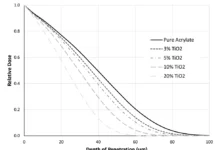Part 1 of this article reviewed the basics of how a low-energy electron beam operates and the commonly consumable parts that are needed to keep it in operation.1 Without any fanfare, let’s dive right back into mid-range consumable parts.
As previously mentioned, the cathode assembly is operated under high vacuum (typically 10-7 Torr). High vacuum is necessary to keep the filaments from being destroyed, as well as to prevent sparking and other problems. These vacuum levels are achieved using a cryogenic pump and compressor, both of which have a three- to five-year lifespan. The compressor also has an adsorber that should be replaced once a year. The vacuum level and the cryo temperature can be tracked to determine when the cryo pump/compressor will need changing. While the vacuum level is dependent on a number of factors, a steady decline over several months, even after a foil change and vacuum regeneration, can be indicative of the cryo pump/compressor not operating as efficiently. This decline usually is accompanied by a rise in the cryo temperature from 10 to 12 K to the high teens or 20 K.
The majority of other parts on an EB are replaced as needed. Screen grids (Figure 1A, Part 11) are replaced when they become bent or torn. Cards in the control cabinet can fail. The high-voltage power supplies need repair over time. And although there are parts that naturally wear out over the years, good maintenance practices most certainly impact the longevity of some individual parts and the overall health of the beam. An example list of periodic inspection and maintenance recommendations can be found at Ref. 2.
In the short term, good maintenance practices equate simply to inspections, record keeping and housekeeping. As with all industrial equipment, regular checks of the safety features (e.g., interlocks, e-stop, etc.) are recommended. In addition, periodic visual inspection of oil levels, pressure levels and filters of a couple of sub-components of the electron beam system can prevent potential future problems.
On a daily or weekly basis, tracking the vacuum level and cryo temperature can help predict when a foil may need replacing or when the cryo pump/compressor need maintenance. If a foil change can be planned ahead of time based on the vacuum trend, it can help minimize downtime. Keeping a log of faults also is exceedingly helpful. Many faults easily are cleared in the moment, but if they repeatedly occur, it can indicate a larger problem. If the beam always is run by the same operator, it might stand out if a fault repeats, but if a beam is operated over multiple shifts, a fault may appear to be a singular occurrence without a record to show otherwise. Newer machines have VPN capability, allowing a beam technician to remotely view certain trends. While this capability is useful in diagnosing an issue, there is a limit to the amount of historical data that can be viewed, and it is not a replacement for a well-kept operator’s log.
Additionally, with some coating and ink processes, a build-up can occur in the area around the foil. Taking care not to damage the delicate foil, cleaning this build-up with a lint-free cloth and isopropanol once a week or so will prevent clogging of the inerting ports. Nitrogen inerting is essential to electron beam polymerization.3 If the ports are not clear, it could cause an operator to increase nitrogen flow to achieve adequate inerting, needlessly increasing operating costs.
The changing of foils and filaments was discussed in Part 1 of this article.1 These maintenance procedures typically are required every four to six months and once a year, respectively. It is beneficial for troubleshooting purposes to record these maintenance procedures in the operation log. Determining whether a problem first occurred before or after routine maintenance can help pinpoint the cause. In addition, if foil changes, for example, feel like they are becoming more frequent, the timing can be compared to the log history and investigated, if needed. Similarly, a record of how and where foils fail can be equally as revealing. If multiple foils fail in the same location, it could indicate an area of high temperature on the window, which should be further inspected to prevent long-term issues.
Downtime is required for both a foil loss and/or filament change. The amount of time can range depending on the issue and the experience of the maintenance team. If a foil is lost, a gate valve should close and preserve the vacuum in the cryo pump. An experienced maintenance person then can replace a foil in as little as an hour or two on a narrow machine. A filament change takes more time – generally about a day. In addition, during a filament change, the vacuum is regenerated, meaning the cryo pump is allowed to warm up to room temperature, then recooled to ~12 K. The cooling process takes approximately two hours once the machine is put in order. After foil or filaments have been replaced, the beam will need to be reconditioned. Conditioning is a process of incrementally bringing the beam up to power, and, again, the required time can vary depending on how long the machine was without vacuum, cleanliness of the cathode (gloves, yes! fingerprints, no!), the size of the machine and the power level to which it needs to be conditioned.
One way to minimize downtime is to plan a preventive maintenance (PM) visit with a beam technician. These visits are scheduled once a year, and, in addition to replacing filaments, foil and the O2 cell, include tasks like checking the filament/grid calibrations and inspection of the cathode. Usually, a PM is scheduled for two days on a smaller beam and three to four days on a larger beam. A PM visit is akin to changing the oil on your car: It is beneficial to the overall health of the beam and can reduce the chance of unexpected failure and unplanned downtime.
Electron beams are built to run for decades in an industrial environment, but they still require good maintenance practices to realize that extended longevity. Keeping a detailed log, ensuring cleanliness and performing preventative maintenance will go a long way toward ensuring smooth and efficient EB operation.
References
- Schissel, S., 2022. A Long-Lived EB: Machine Function and Maintenance, Part 1. UV+EB Technology. (1), 16-17.
- https://www.pctebi.com/customer-service/service-resources/
- Schissel, S., 2021. Comparing EB and UV: Common Questions. UV+EB Technology. (2) 14-15.
Acknowledgements
Rian Lewison, Director of Customer Service at PCT Ebeam and Integration
Wayne Leonard, Beam Technician at PCT Ebeam and Integration
 Sage Schissel, Ph.D.
Sage Schissel, Ph.D.
Applications Specialist, PCT Ebeam and Integration LLC
sage.schissel@pctebi.com







